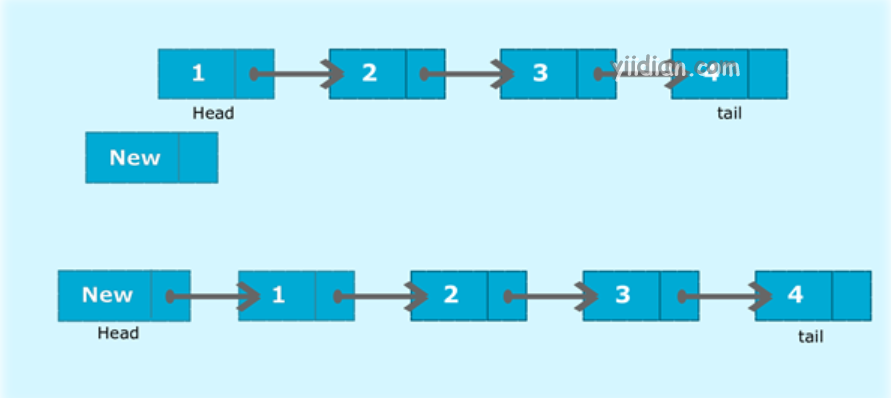在单链表开头插入新节点的Java程序
1 简介
在此程序中,我们将创建一个单链接列表,并在列表的开头添加一个新节点。为了完成此任务,我们将头存储到临时节点temp。将新添加的节点作为列表的新标题。然后,在新头后面添加temp(旧头)。

考虑上面的清单;节点1代表原始列表的头。令node New为需要在列表开头添加的新节点。临时节点将指向头,即1。将New设为列表的新头,并在新头之后添加temp,以使New旁边的节点为1。
2 算法思路
- 创建一个具有两个属性的类Node:data和next。下一个是指向列表中下一个节点的指针。
- 创建另一个具有两个属性的头类InsertStart:head和tail。
- addAtStart()会将一个新节点添加到列表的开头:
- 它首先检查head是否等于null,这意味着列表为空。
- 如果列表为空,则头和尾都将指向新添加的节点。
- 如果列表不为空,则创建临时节点temp将指向head。
- 将新节点添加为列表的头部。
- 指向旧头的温度将在新头之后添加。
- 定义一个临时节点,该临时节点将初始指向列表的开头。
- 遍历列表,直到当前指向null。
- 通过在每次迭代中使临时节点指向其旁边的节点来显示每个节点。
3 程序实现
/**
* 一点教程网: http://www.yiidian.com
*/
public class InsertStart {
//Represent a node of the singly linked list
class Node{
int data;
Node next;
public Node(int data) {
this.data = data;
this.next = null;
}
}
//Represent the head and tail of the singly linked list
public Node head = null;
public Node tail = null;
//addAtStart() will add a new node to the beginning of the list
public void addAtStart(int data) {
//Create a new node
Node newNode = new Node(data);
//Checks if the list is empty
if(head == null) {
//If list is empty, both head and tail will point to new node
head = newNode;
tail = newNode;
}
else {
//Node temp will point to head
Node temp = head;
//newNode will become new head of the list
head = newNode;
//Node temp(previous head) will be added after new head
head.next = temp;
}
}
//display() will display all the nodes present in the list
public void display() {
//Node current will point to head
Node current = head;
if(head == null) {
System.out.println("List is empty");
return;
}
System.out.println("Adding nodes to the start of the list: ");
while(current != null) {
//Prints each node by incrementing pointer
System.out.print(current.data + " ");
current = current.next;
}
System.out.println();
}
public static void main(String[] args) {
InsertStart sList = new InsertStart();
//Adding 1 to the list
sList.addAtStart(1);
sList.display();
//Adding 2 to the list
sList.addAtStart(2);
sList.display();
//Adding 3 to the list
sList.addAtStart(3);
sList.display();
//Adding 4 to the list
sList.addAtStart(4);
sList.display();
}
}
输出结果为:
Adding nodes to the start of the list:
1
Adding nodes to the start of the list:
2 1
Adding nodes to the start of the list:
3 2 1
Adding nodes to the start of the list:
4 3 2 1
热门文章
优秀文章


